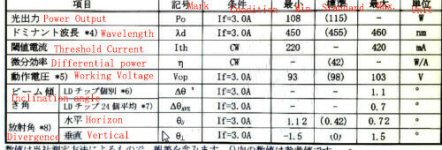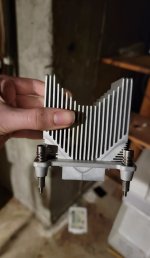damian369
New member
- Joined
- Sep 8, 2020
- Messages
- 2
- Points
- 3
thank you .I order the glasses immediately

Follow along with the video below to see how to install our site as a web app on your home screen.
Note: This feature may not be available in some browsers.



Tease!The documentation in this thread is first rate, so good I want more!
I'd also like to put one of these blue laser diode arrays in a large host I have, but I'd have to expand the beams a lot to reduce the divergence as well as help join the individual beam outputs to appear more like a single beam, not really possible to make it appear as one beam that way, but I think I can get it to approximate one.
I'm working on a multi-diode Nichia NDG7D75-E 525 nm pointer and what you are saying is well taken, it takes time and adjustments to get it right, I'm hoping this one won't require multiple trips to a machine shop. It's going to break the mold when done, unique in more than one way.






I have not worked with this device for years, but have a recommendation. Acquire a lab power supply with independent voltage and current limits! Plan to work with a single row of diodes at a time initially. I DO NOT recommend putting the four rows in series until you know what to expect. Set the lab supply to a very low current, maybe 50mA, and 0 volts. Turn up the voltage slowly until the row emits light. It is important to know what minimum voltage is required. This allows experimenting at low power; this device is quite dangerous – even at fraction of rated output. In addition, it will get quite hot very fast, powering a single row will help avoid heating problems. At full power, I doubt that the shown heat sink would be adequate without a good strong fan.First off, apologies for necroing a 2 year old thread. You guys were one of the only people on the internet talking about this.
Hey, I recently acquired a 115w Nubm34 laser diode for cheap off Ebay (got it off a auction). I'm trying to make a circuit to make it work and was wanted to check with you guys if it is dangerous.
I'm going to be using LM338T's for the main driver. I watched the styropyro video in the thread and it said I shouldn't be running them at over 3 amps. However the manufacturer rates them at being able to 5amps at 40volts. So this is something I wanted to check would not blow a hole in the diode. However I also want to make sure my choice of batteries would be alright, I was hoping to make this portable. I'm going to be using 2 Zeee 14.8V 2200mAh 50C 4S Lipo Battery's to power the circuit. I'm hoping these would be powerful enough as for some reason the only specs sheet I can find on these things states they should be run at 96v 3amps! I assume thats the whole diode and not every lane.
View attachment 74629
I'm thinking i'm going to run it at 30v (because of the two batteries), but how much should I turn up the ampage?
To make sure I don't blow up the diodes or my eyes. I'm using a old Xeon server heatsink I had lying around from a old computer, alongside with some mid quality thermal paste. I would assume this would be enough to cool this diode for short bursts. I might try and get a better paste though or a foil of some kind to replace the spare cooling supplies I have just lying around.
View attachment 74630
For glasses i'm going to be using some Freemascot OD 6+ 190nm-550nm goggles. They seem a little cheap but that seems just to be in the frames. Most of the money seems to go to the lenses and they seem like enough to protect my eyes. The only thing is they don't fit incredibly snug, So I'm going to use a little duct tape and plastic to block out the goggles a bit more for those bits were lasers could possibly get through.
Is there anything wrong with this design? I assume I should add some capacitors but I don't really know any that could handle this high of a wattage. Would anyone have any suggestions. Apologies you guys just seem like the only persons who would know. Thank you very much
Ah alright, thanks. I've watched quite a decent chunk of styropyro already. Thankfully it seems only the parts I knew would be a problem were a problem. Just glad those LM338T's don't seem like a problem. I have a friend with a power supply like that so i'll borrow it before I start ordering batteries and such. I was thinking of getting a better heatsink or even some kind of watercooling but assumed this would be enough for a good bit, as Styropyro usually uses severe underkilling heatsinks and they work fine. I harvested this from a old ATX tower PC that was used as a server with a xeon chip that could easily hit 100w of cooling. I had no idea this could hit that high, thanks!I have not worked with this device for years, but have a recommendation. Acquire a lab power supply with independent voltage and current limits! Plan to work with a single row of diodes at a time initially. I DO NOT recommend putting the four rows in series until you know what to expect. Set the lab supply to a very low current, maybe 50mA, and 0 volts. Turn up the voltage slowly until the row emits light. It is important to know what minimum voltage is required. This allows experimenting at low power; this device is quite dangerous – even at fraction of rated output. In addition, it will get quite hot very fast, powering a single row will help avoid heating problems. At full power, I doubt that the shown heat sink would be adequate without a good strong fan.
If you have not worked with a high power laser diode previously, AND a voltage & current lab supply, please do this first. It is all too easy to inadvertently cause extreme injury even if you are the most careful person on the planet.
Watch Styropyro's Youtube videos!!!!!!!!!!!!!!!

